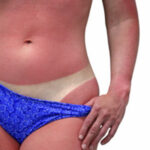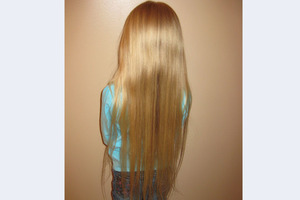Exposure to the sun damages the skin. Depending upon the extent of time exposed to the sun, frequently as sun worshiper or occasionally doing out-door gardening, the sun’s ultraviolet (UV) rays damages the fibers in the skin called elastin. Eventual damage to skin varies from developing superficial wrinkles to deadly type of skin cancer. Experiencing severe sunburns before the age of eighteen may cause later in life melanoma (Malignant tumor or cancer in the skin. “It is one of the rarer type of skin cancer but causes the majority of skin cancer related deaths .” 2 Statistically one serious sunburn increases the risk by as much as 50% 9) 1 Sunlight damages the skin by harmful ultraviolet (UV) rays – UVA and UVB. Unless blocked by a window glass the UVB rays primarily cause sunburn and skin cancer. UVA rays (which pass through window glass) penetrate deeper into the dermis or base layer of the skin.” Sunscreen protection measured by Sun – Protection Factor (SPF) protect the skin from UVB rays, but not UVA rays, cause cancer and other diseases. 3 Equally damaging to the skin is UV light exposure from tanning beds.1
Skin exposure to the sun cause superficial to serious health concerns:
Elastosis (Appearance of lines and wrinkles result of destruction of elastic tissue. Commonly appears around the lips 4)
Telangiectasias – (Blood vessels under the skin become dilated 1. Also, called facial spider veins, appear as little red veins on the nose, chin, or checks. 5)
Sallowness (“a yellow discloriation of the skin”.)
motted pigmentation (Discolored areas of the skin)
Freckles (Ephelides – Appearance of freckles more apparent after long sun exposure compared during winter months less predominant 6),
Fine course wrinkles
Benign tumors (non- cancer including appearance of moles. 7 The Diagnosis confirmed by characteristic appearance, patient’s clinical history and / or biopsy. The benign tumor is generally removed 8)
Actinic keratosis (pre-cancerous) or cancerous carcinoma (base cell melanoma (In 2007 nearly 8,110 deaths resulted 10))
Squamous cell carcinoma (Second most common form of skin cancer and attributed to approximately 2,500 deaths each year.10)) skin lesions. 1
Development of skin cancer is predominately increased when hereditary incidences occur. Development of skin cancer most susceptible are northern European heritage people with fair skin. In the United States, estimate one in seven people will develop some form of cancer in their lifetime. 9 “More than 1 million skin cancers are diagnosed annually. 10
In 1978, Dr. Bill Elliott Cham (Brisbane scientist, University of Queensland Department of Medicine – November 2006 15) observed a cow rubbing against (11) ‘Devil’s Apple’ leaf (Australian botanical plant 13) and cured itself of cancer around it’s eye. “The ‘locals’ (Aborigines 15) refer to the weed as Devil’s Apple or Kangaroos’s Apple; however the more correct reference is Sodom’s Apple.”12 Another story was told; How Dr. Cham learned about ‘Devil’s Apple’ from aborigines, used the juices to stop eye cancer. 15 Dr. Cham experimental research on ‘Devil’s Apple’ discovered chemical compound, Glycoalkaloid solasodine glycosides biochemical (BEC). Its properties produce an anti-cancer activity in humans and animals. 11 During the 1980s, Dr. Cham further studied Glycoalkaloid as treatment for skin cancer and founded the Glycoalkatoid cancer research. He discovered active ingredients in ‘Devils Apple’, found in eggplant as effective treating skin cancer. The research guided Dr. Cham to develop Curaderm-BEC5 (Mixture of tryglycosides, solasonine and solamargine 14) topical cream. Dr. Elliott Charm studied the effectiveness of Curaderm-BEC5 for five years on human keratoses basal, cell carcionoma, sequomous cell carcinomas and other human skin cancers.11 The effectiveness of the treatment did not harm normal healthy human cells. According to Dr. Cham, cancer introduced into mice was eliminated after Curaderm-BEC5 treatment, and subsequently the mice lived a full life span. 15 Conclusion of Dr. Elliott Charm study, showed 100 percent regression of skin lesions. “Many of his patients have been cancer-free for 10 years or more”. Documentation of Dr. Cham study has been published in medical journals. 11 Dr. Bill E. Charm wrote the book: “The Eggplant Cancer Cure: A Treatment for Skin Cancer and New Hope for Other Cancers from Nature’s Pharmacy (published by Smart Publications – November 2007) 18
Curaderm-BEC5 works specifically to attack cancer cells, contrary to other anti-cancer drugs, non-specifically destroy cancerous and normal cells at the same time. Curaderm-BEC5 contains two Glycoalkaloids: Solasonine and Solamargine perform specific functions to attack cancer cells. “Solasonine, identifies the cancer cells and then enters the membrane of the abnormal cell. Solamargine, destroys the stomach of the cancer cell eliminating its existence”. 14
In 2002, Phase three trial study (out – patient treatment) concluded by the Royal London Hospital confirmed topical preparation Curaderm-BEC5 destroys non-Melanoma cancer cell without harming normal healthy cells. Also, trial study confirmed Curaderm-BEC5 better alternative treatment compared to surgery (unnecessarily remove nose, eyes, ears or risk death undergoing surgery), radiotherapy or other conventional treatment methods. Microscopic or histological examination confirmed zero presence of basal cell carcinoma. Curaderm-BEC5 side effects may include skin irritation and reddening (erythema) during treatment. 16 Also, likely to occur shedding of unwanted skin cells. “BEC5 should not be used by persons who are allergic to eggplant or aspirin”. Recommend children less then twelve years old, seek advice from a physician, before starting Curaderm-BEC5 application. 24
Curaderm-BEC5 applied topically twice a day (After breakfast and before bedtime) or more frequently, after cleaning the surface area of the skin. Normally the area to be treated does not extend longer than approximately two inches by two inches. 17 “Curaderm-BEC5 should be applied in a thick layer over the treatment area and then covered using a dressing (micropore).” (Micropore tape available in most drugstores) A discharge of pus (oozing) indicate dead cancer cells are being pushed out from the skin tissue. Treatment is concluded when new skin tissue has re-grown. 21 “Application should continue for a minimum of 7 days and a maximum of 60 days, this time dependent upon the size, need and regularity of applicatin”. 24 Prematurely stopping treatment may cause skin cancer to grow back. When the topical treatment is applied to the inside of the lip, follow instructions carefully, risk causing damage in the mouth. .21 Unknown if Curaderm-BEC5 harmful to pregnant women or women who are breast feeding (NO information available if Curaderm-BEC5 may pass into the milk and effect the fetus or baby). Also, unknown if Curaderm-BEC5 may adversely affect other medications or herbal treatment being taken. Always notify your doctor or physician if you had other treatments for skin cancers. “Use Curaderm-BEC5 only on area of the body to be treated.” 17
Curaderm-BEC5 available for purchase: Website Bio-National Pharmaceuticals (800 – 378 – 8428 USA /Canada). The product specific usage according to the manufacture guideline: Basal Cell Carcinomas, Squamous Cell Carcinomas, Keratoacanthomas, and Keratoses (Sun spots – Lesions on the skin appear flat, tan, brown or dark brown spots as result of frequent sun exposure. Frequently appears on back of hands, the forearms, chest, neck, and face: Maybe at risk develop skin cancer. 19). 22 “A 20ml. bottle of BEC5 can provide enough material to treat one large skin cancer, two medium sized ones, six small ones or twelve sun spots”. 24 In Australia, the Therapeutic Goods Administration (TGA), equivalent to the FDA in the United States, approved the sale of Curaderm-BEC-5 over the counter and for use of sunspots and keratoses, except did not approve the usage for therapeutic cancer treatment. 22 BEC-5 topical treatment disclaimer notice: “This product and its statements have not been evaluated by the FDA. This product is not intended to treat, cure or prevent any disease.” 20 According to Food and Drug Administration ruling in 1988, U.S. citizens allowed import a three month supply of medication for personal use. 23
More information available on Cuarderm-BEC5 at the Web site – Curaderm.net
References:
.
1.) Cosmetic Procedures: Sun Exposure and Skin Cancer – http://www.webmd.com/skin-beauty/guide/sun-exposure-skin-cancer
2.) Melanoma – http://en.wikipedia.org/wiki/Melanoma
3.) Sun Damage – http://www.mckinley.uiuc.edu/Handouts/sun_damage.html
4.) elastosis – http://www.answers.com/topic/elastosis?cat=health
5.) Facial Telangiectasias – http://www.lourdes.com/Centers_and_Services/Laser/facial_telangiectasias.aspx
6.) Ephelides (Freckles) –
http://www.emedicine.com/derm/topic121.htm
7.) Benign tumor – http://en.wikipedia.org/wiki/Benign_tumor
8.) Common Benign Skin Tumors –
http://www.aafp.org/afp/20030215/729.html
9.) An Introduction to Skin Cancer – http://www.maui.net/~southsky/introto.html
10.) 2007 Skin Cancer Facts – http://www.skincancer.org/skincancer-facts.php
11.) About Curaderm – BEC5 – Clinically Proven Skin Cancer Treatment – http://www.cura-care.com/about-curaderm.htm
12.) How did Dr. Bill Cham discover Curadem – http://server.iad.liveperson.net/hc/s-31526830/cmd/kbresource/kb-2584369167913176630/view_question!PAGETYPE?sf=101133&documentid;=232337&action;=view
13). Skin Deep – http://www.hsibaltimore.com/ealerts/ea200311/ea20031119.html
14.) “The History of Curaderm” – http://www.bionational.com/xcart/catalog/Curaderm-History.html
15.) NEW HOPE FOR SKIN CANCER – http://skincancerfaq.typepad.com/featured_case_studies_/2006/11/new_hope_for_sk.html
16.) Curaderm BEC5 Medical Research – http://www.cura-care.com/research/uk-clinical.htm
17.) Patient Information – Curaderm BEC5 – http://www.curaderm.net/treatmentexamples/patientinfo.aspx
18.) The Eggplant Cancer Cure: A Treatment for Skin Cancer and New Hope for Other Cancers from Nature’s Pharmacy – http://search.barnesandnoble.com/booksearch/isbninquiry.asp?r=1&ean;=9781890572211
19.) Your Skin – Sun Spots & Pigmentation – http://www.radiancealtamonte.com/YourSkin/SunSpots.aspx
20.) Curaderm / BEC5 Cream 20ml – http://www.antiaging-systems.com/apruses/curaderm.htm
21.) Skin Cancer Forum – http://www.topicalinfo.org/forum/topic.asp?TOPIC_ID=61
22.) Curaderm-BEC5 cream (20ml) – http://www.prestostore.com/catalog.php/georgeapple/dt4243/pd428503/Curaderm_BEC5_cream_20ml_.
23.) Importing Curaderm-BEC5 for personal usage –
http://server.iad.liveperson.net/hc/s-31526830/cmd/kbresource/kb-2168190713595121448/view_question!PAGETYPE?sf=101133&documentid;=232339&action;=view
24) BEC5 (Curaderm) Product Information – http://www.biogenesis-antiaging.com/p16/BEC5-(Curaderm)/product_info.html


